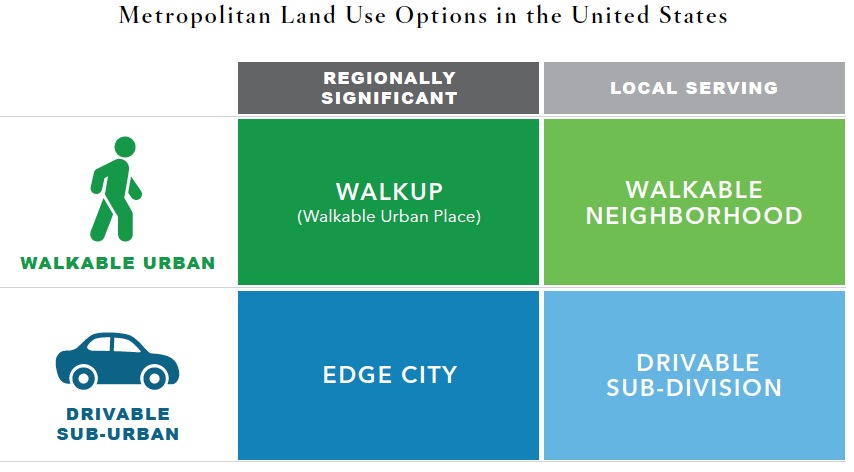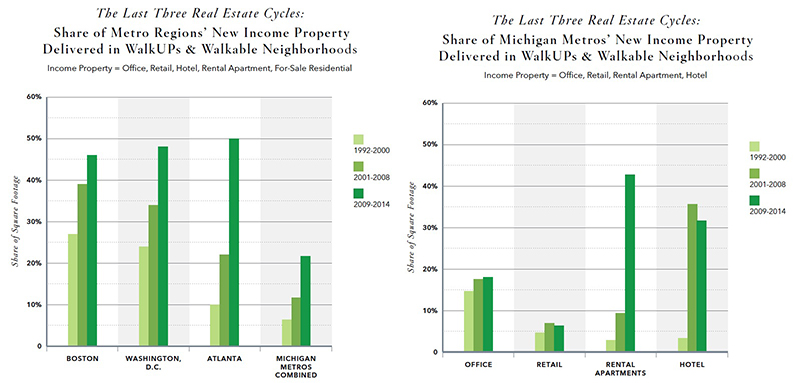LOCUS
SMART GROWTH AMERICA
 Walkable urban places are not just a phenomenon of coastal U.S. metropolitan areas. This report demonstrates that the market desires them in Michigan—and they are gaining traction. If this emerging trend in favor of walkable urbanism plays out in Michigan as it has in the other metro areas studied by George Washington University—Atlanta, Boston, and Washington, D.C.— it will mean an historic shift away from the drivable development patterns that have dominated development for the latter half of the 20th century. The state could return to the walkable urban development pattern that predominated before World War II.
Walkable urban places are not just a phenomenon of coastal U.S. metropolitan areas. This report demonstrates that the market desires them in Michigan—and they are gaining traction. If this emerging trend in favor of walkable urbanism plays out in Michigan as it has in the other metro areas studied by George Washington University—Atlanta, Boston, and Washington, D.C.— it will mean an historic shift away from the drivable development patterns that have dominated development for the latter half of the 20th century. The state could return to the walkable urban development pattern that predominated before World War II.
Consider that in the current real estate cycle in the seven metro areas evaluated in this report (Detroit-Ann Arbor, Flint, Grand Rapids-Muskegon-Holland, Jackson, Kalamazoo-Battle Creek, Lansing, and Saginaw-Bay City-Midland, the “Michigan Metros”) 22 percent of all new income property development has located in the 2.7 percent of land that is walkable urban. This share of new development is up from only 6 percent in the 1990s real estate cycle and 12 percent from the 2001-2008 cycle. Boston and Washington, D.C. provide an indication of how far this trend can go. Their shares of new income property development located in walkable urban places in the most recent cycle have been 46 percent and 48 percent respectively.
Walkable places’ increasing share of development is most likely a response to pent-up market demand. Because drivable development patterns dominated for so long, residents of Michigan have had few choices about where to live. Only eight percent of the total housing stock is located in a walkable urban place and only half of that was built after 1960, meaning a significant portion may be obsolete. This is despite national polls suggesting that at least 40 percent of residents would like to live in a walkable urban place and demographics that increasingly favor urban living. Sixty-four percent of Michigan households have just one or two persons, the target market for walkable urbanism, and the percentage is rising.
This pent-up demand is reflected in rents and prices. Across all the Michigan Metros analyzed, average office rents in regionally significant walkable urban places are two percent higher than in comparable drivable locations, retail rents are 13 percent higher, multifamily rental apartment rents are 28 percent higher, and for-sale residential prices are 50 percent higher. These are crude averages that hide significant variation among and within metro areas, but the broad implication is clear—there is pent- up demand for walkable urban places in Michigan.
Nonetheless, progress is uneven. Places like Downtown Birmingham, Main Street in Ann Arbor, and Downtown Grand Rapids provide a glimpse of the full potential of walkable urbanism to create value. Downtown and Midtown Detroit have demonstrated how rapidly revitalization can occur over just the last five to seven years, while plans being made in Lansing for a bus-rapid transit corridor show the way forward. However, there is a longer list of walkable urban places that have not taken off. For some of these places, government support, aggressive placemaking, and a few pioneering developments may be enough to introduce dramatic change. For others, it may be more a question of time and an improvement in the overall regional economy.
All of the metro areas, if not the entire State of Michigan, has an economic, fiscal, and social equity interest in seeing these walkable places thrive. Although it has not been possible thus far to definitively prove causation, the circumstantial evidence is mounting that young, educated members of the workforce, the foundation of future economic development, want to live and work in walkable urban places. Previous research, confirmed again here, finds a positive correlation between the walkability of a metro area and the educational attainment of its residents, an important factor for economic performance. In the context of a state that is rightly concerned about brain drain, improving the quality and quantity of these walkable urban places must be a part of the policy discussion.
Download full version (PDF): Michigan Metros
About LOCUS
www.smartgrowthamerica.org/locus
LOCUS, Latin for “place,” is a national coalition of real estate developers and investors who know that transportation drives development and who advocate for sustainable, walkable urban development in our metropolitan areas…LOCUS serves as a vital voice for real estate developers and investors to guide federal policy towards market driven trends that are more economically, socially and environmentally sustainable for America’s future. LOCUS members bring hands-on experience and expertise on how America can create more jobs, increase property values and provide sustainable economic growth.
About Smart Growth America
www.smartgrowthamerica.org
Smart Growth America advocates for people who want to live and work in great neighborhoods. We believe smart growth solutions support thriving businesses and jobs, provide more options for how people get around and make it more affordable to live near work and the grocery store. Our coalition works with communities to fight sprawl and save money. We are making America’s neighborhoods great together.
Tags: Detroit, George Washington University School of Business, LOCUS, MI, Michigan, Midwest, Muskegon, Smart Growth America







 RSS Feed
RSS Feed